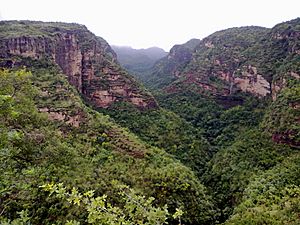Satpura Range facts for kids
The Satpura Range is a long chain of mountains and hills in central India. It stretches across the states of Madhya Pradesh and Maharashtra. To its north flows the mighty Narmada River, and to its south is the Tapi River. This mountain range is famous for its beautiful nature and the many different plants and animals that live there. It's also home to several tribal communities.
Contents
Satpura Range: India's Mountain Chain
The Satpura Range is one of the most important mountain ranges in India. It runs from east to west, starting in eastern Madhya Pradesh and going all the way to the Nandurbar district in western Maharashtra. The word "Satpura" means "Seven Folds," which might refer to the many parallel ridges and peaks that make up the range.
Where is the Satpura Range Located?
The Satpura mountains act like a natural border between the Narmada River valley in the north and the Tapi River valley in the south. The Narmada River flows through a rift valley (a valley formed by the Earth's crust pulling apart) between the Satpura and the Vindhya Range to its north. The Tapi River flows parallel to the Satpura Range further south. The highest parts of the Satpura Range are generally in the west, and the hills gently slope downwards towards the east.
What is the Satpura Range Like?
The Satpura Range is known for its rich biodiversity, meaning it has a wide variety of life forms. It has dense forests, deep valleys, and high plateaus. The mountains are mostly made of igneous rocks, like basalt, which were formed from ancient volcanic activity. Over time, these rocks have been shaped by weather and water, creating the landscapes we see today.
Important Peaks and Plateaus
While the Satpura Range isn't as tall as the Himalayas, it has several notable peaks and plateaus. One of the most famous is Dhupgarh in the Mahadeo Hills near Pachmarhi. It is the highest point in the Satpura Range. Another important area is the Toranmal hill station, which is a popular spot for visitors.
Plants and Animals of Satpura
The Satpura Range is a haven for wildlife. Its forests are home to many different types of trees, plants, and animals.
Forests and Vegetation
The lower slopes and valleys have deciduous forests, which means the trees lose their leaves in the dry season. You can find trees like teak, sal, and bamboo here. Higher up, the vegetation changes, and you might find more evergreen trees. These forests are vital for maintaining the region's ecosystem.
Wildlife and Conservation
The Satpura forests are home to many amazing animals. You can find large mammals like Bengal tigers, leopards, sloth bears, and gaur (Indian bison). There are also many types of deer, such as chital (spotted deer) and sambar. Birdwatchers can spot a wide variety of birds. To protect this rich wildlife, several national parks and wildlife sanctuarys have been established within the Satpura Range, such as the Satpura National Park. These protected areas help ensure that these animals and their habitats are safe for future generations.
People of the Satpura Hills
The Satpura Range has been home to various tribal communities for centuries. These communities have a deep connection with the land and its resources.
Tribal Communities and Culture
Many different tribal groups live in the Satpura hills, including the Gonds, Bhils, and Korkus. They have their own unique cultures, languages, traditions, and ways of life. Their livelihoods often depend on the forest, through farming, collecting forest products, and traditional crafts. They have a rich heritage of folk songs, dances, and festivals.
Living in Harmony with Nature
These communities have traditionally lived in harmony with nature, using resources sustainably. They have a vast knowledge of the local plants and animals. Efforts are being made to support their traditional practices and ensure their rights are protected while also conserving the natural environment.
Important Places in Satpura
The Satpura Range is not just about mountains and forests; it also has several places that are important for tourism and history.
Hill Stations and Tourist Spots
- Pachmarhi: Known as the "Queen of Satpura," Pachmarhi is a beautiful hill station in Madhya Pradesh. It's famous for its waterfalls, caves, and scenic viewpoints. It's a popular place for people to relax and enjoy nature.
- Toranmal: Located in Maharashtra, Toranmal is another charming hill station in the Satpura Range. It offers peaceful surroundings and beautiful views.
- Amarkantak: While not strictly within the main Satpura range, Amarkantak is an important pilgrimage town located in the Maikal Hills, which are considered an eastern extension of the Satpura Range. It is the source of the Narmada River and the Son River.
Historical and Cultural Significance
The Satpura Range also holds historical importance. Many ancient caves, temples, and forts can be found here, showing the long history of human settlement in the region. These sites often have unique architecture and carvings that tell stories of the past.
See also
 In Spanish: Cordillera Satpura para niños
In Spanish: Cordillera Satpura para niños


